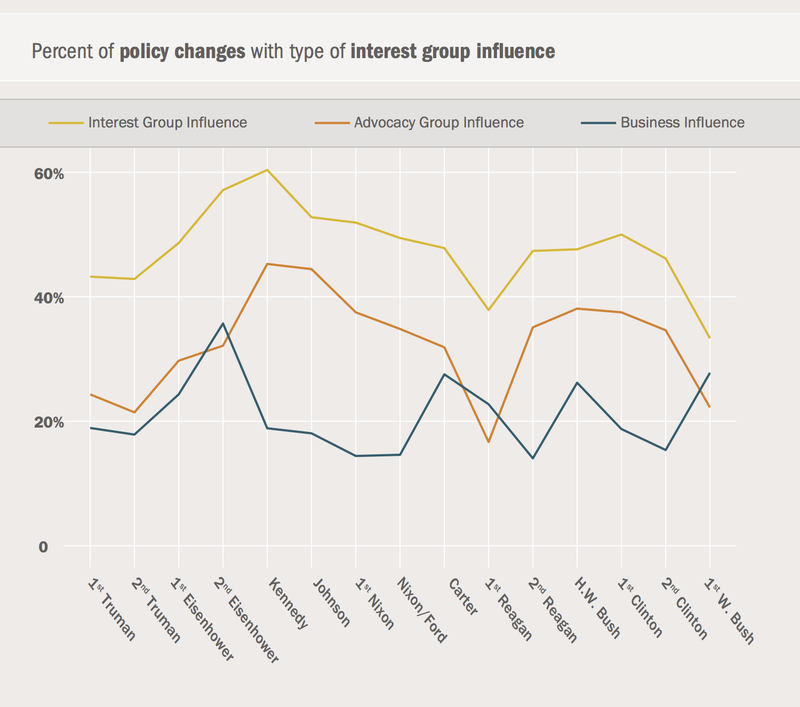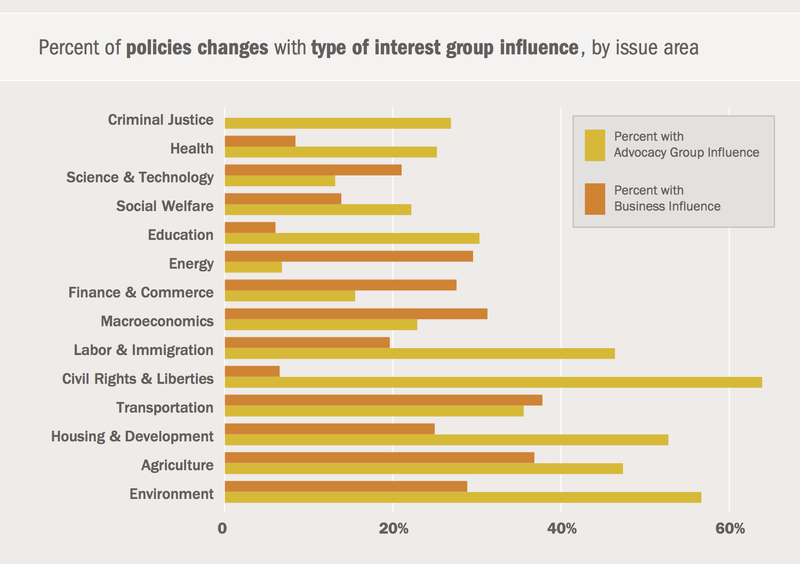Who has a say in Washington: Policymakers listen to interest groups instead of the public
A broad, increasing majority of the American public believes that “the government is pretty much run by a few big interests looking out for themselves” rather than “the benefit of all of the people.” Yet academic researchers have found it difficult to prove that campaign contributions or lobbying dollars usually buy policy influence in any straightforward way, especially when interest groups are trying to change current policies.
To assess how often interest groups play important roles in significant policy change, I rely on qualitative assessments by historians studying domestic policy issues. My new book, Artists of the Possible: Governing Networks and American Policy Change Since 1945, compiles 790 significant domestic policy changes, mostly landmark laws passed by Congress. The results show a high level of reported interest group influence: Policy historians cite interest groups in explanations for policy change more often than public opinion, research, events, ideas, the media or courts. In this respect, historians agree with the public: Policymakers listen to interest groups instead of us.
But two patterns are more surprising. First, reported interest group influence is not increasing, even though the number of organizations and lobbyists have increased dramatically. Second, the interest groups credited with significant policy change are often advocacy groups that claim to represent the public, rather than the businesses and trade associations that are much more numerous.
The graph below (Figure 1) tracks the percent of significant policy changes during each presidential administration where policy historians reported interest group influence. Despite the substantial increase in interest groups since the 1960s, there is little evidence of an increase in their aggregate reported influence. Even though business interests substantially outnumber advocacy groups, policy historians usually credit advocacy group influence more often than business influence—with exceptions during the administrations of Dwight Eisenhower, Ronald Reagan and George W. Bush.

Reported interest group influence on major policy change closely tracks the reported influence of advocacy groups, rather than business interests, because most policy changes credited to business interests also involved advocacy groups. The interest groups credited with policy changes most often since 1945 were the AFL-CIO, the NAACP, the U.S. Conference of Mayors and the ACLU. The business interests credited most often were broad peak associations like the Chamber of Commerce. Some citations of business influence were general references to industries or business as a whole, but nearly all advocacy group references cited a specific organization.
These aggregate patterns hide important variation across domestic policy issue areas. Figure 2 below reports the percent of policy changes in each issue area where policy historians credited advocacy groups and business interests. Advocacy group influence is most common in the areas of civil rights and liberties, the environment, and housing and urban development. Reported business influence is more common than advocacy group influence in other areas important to business: finance and commerce, energy, macroeconomics and technology. Lobbying activities and interest group mobilization are concentrated in a few issue areas, and business interests specialize in different areas than advocacy groups. Where business is most involved, they are reportedly more influential.

Two caveats are in order: First, this analysis is based on the collective judgments of policy historians in each issue area. I did not find major differences in their judgments based on their academic training or research strategies—but if historians share biases, they will be reflected in my results. Past results are also, of course, no guarantee of future returns: The most active period of domestic policymaking occurred in the 1960s and 1970s in a golden era of deal making that is far different from our own.
Second, my investigation only includes successful policy changes. Business interests are more likely to oppose policy changes than support them; their main advantage may be in supporting the status quo over any change. Advocacy groups may also push for more significant policy changes. Business interests often desire tweaks in tax policy, small appropriations or changes in regulations. In most of the large domestic policy issues, many industries do not have a clear position. Much of what business wants and needs tends to be lower salience.
Nonetheless, the evidence from policy history should not be dismissed. The qualitative evidence collected by historians is often quite strong; they may cite a key provision of a new law written by a lobbyist, policymaker recollections that a group endorsement tipped the balance of support, or a group’s long-running involvement in building support for change.
These results may seem at odds with new research, introduced with great fanfare, by Martin Gilens and Benjamin Page. The new study showed that the opinions of top business groups were better predictors of policy adoption than the opinions of mass-based organizations (advocacy groups and unions). The studies have several critical differences. First, their study included only 5 public interest groups (mostly conservative) and only 2 of the top 28 advocacy groups credited by policy historians (missing, for example, all environmental, consumer and civil rights groups). Second, the interest groups they studied mostly succeeded in blocking policy change. On average, they favored 54 policy changes and opposed 94; their average success rate in blocking change was 74% but their success in favoring change was barely above 50/50. Third, the new study’s evidence of interest group influence is the association between their public views and policy results, whereas mine is a qualitative assessment by policy historians.
Nevertheless, there are some similarities. The most involved business groups in the Gilens and Page study are the same as mine: the Chamber of Commerce and the National Association of Manufacturers. They find high success rates by technology industries, matching my issue categorization. They find low success rates among unions, matching evidence from my study (except for the AFL-CIO). Liberal groups oriented around post-material concerns are likely more influential than unions. Policy history also shows that on some important issues (like energy and finance), and during some administrations, business is more likely to be involved in policy change than advocacy groups.
The view from policy history should reinforce some public worries: Interest groups are cited nearly as often as legislators and administrators in stories of policy change. The direct role of public opinion in policy is comparatively muted. The findings may temper other public concerns. Broad advocacy groups representing public interests are at least as involved in significant policy change as narrower business interests, even though they are substantially outnumbered and outspent. The explosion of new interest groups has failed to dislodge the continuing role of the major advocacy groups and broad business associations.

